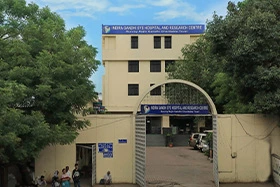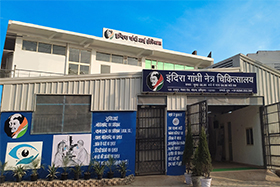- Applanation tonometry
- Gonioscopy
- HFA – Humphery Field Analyser (Zeiss)
- OCT- Optical Coherence Tomography (Zeiss)
- Fundus photography (Zeiss)
- ASOCT – Anterior segment Optical Coherence Tomography (Zeiss)
- Email: enquiry@indiragandhieyehospital.com
- Call: 01242710271
Specialties
Laser Treatment for Glaucoma in Delhi
Glaucoma is a serious condition that threatens eyesight, typically manifesting as a painless, gradual loss of vision. Unfortunately, lost vision cannot be recovered, but medical or surgical treatments can prevent or slow further vision loss.
_11zon.webp)
Don't Confuse Glaucoma with Cataracts
While both glaucoma and cataracts cause a painless, gradual loss of vision, they are different conditions. Cataract-related vision loss is fully recoverable through a simple surgery called Phaco, whereas glaucoma-related vision loss is not.
How Glaucoma Affects the Eye
Our eyes produce a clear fluid called aqueous humor, which nourishes internal structures. Normally, this fluid drains through canals in a meshwork around the iris (the colored part of the eye). In people with glaucoma, the fluid fails to drain properly, leading to increased pressure inside the eye, known as raised Intraocular Pressure (IOP).
Who Is at Risk for Glaucoma?
Anyone can develop glaucoma, but some individuals are at higher risk:
- People over the age of 40
- Those with a family history of glaucoma
- Diabetics
- Individuals with nearsightedness (myopia) for open-angle glaucoma and farsightedness (hyperopia) for angle-closure glaucoma
- People with hypertension
- Individuals who suffer from migraines
Common Symptoms of Glaucoma
Glaucoma often progresses without noticeable symptoms until significant vision loss occurs. However, if untreated, the following symptoms may appear:
- Eye pain when transitioning from darkness to light (e.g., leaving a cinema hall)
- Colored halos around lights, especially in the mornings and evenings
- Frequent changes in reading glasses, headaches, eye pain, and redness
- Reduced vision in dim light and at night
- Gradual loss of peripheral vision as glaucoma progresses
Types of Glaucoma
Open-Angle Glaucoma
Open-angle glaucoma occurs when the eye's drainage canals become clogged over time, causing a rise in intraocular pressure (IOP) because fluid cannot drain properly. While the entrances to the drainage canals remain clear and open, the clogging occurs further inside, similar to a clogged pipe beneath a sink. Most people experience no symptoms or early warning signs. If undiagnosed and untreated, it can lead to gradual vision loss. This type of glaucoma develops slowly, often without noticeable sight loss for many years, and usually responds well to medication if caught early. It is more common in Caucasians.
Angle-Closure Glaucoma
Also known as acute or narrow-angle glaucoma, this type is more common in Asians and differs significantly from open-angle glaucoma. The eye pressure rises very quickly due to the narrow or covered entrance to the drainage canals, like a sink with a covered drain. Symptoms may include headaches, eye pain, nausea, rainbows around lights at night, and very blurred vision.
Low-Tension or Normal-Tension Glaucoma
In this type, the optic nerve is damaged despite normal intraocular pressure (IOP). Lowering eye pressure by at least 30 percent with medication can slow the disease in some people. Identifying risk factors, such as low blood pressure, is crucial. If no risk factors are identified, treatment options are similar to those for open-angle glaucoma.
Congenital Glaucoma
Children are born with a defect in the eye's angle that impedes normal fluid drainage. Visible symptoms often include cloudy eyes, sensitivity to light, and excessive tearing. Conventional surgery is typically recommended, as medications may have unknown effects on infants and be difficult to administer. Prompt surgery is safe, effective, and usually ensures a good chance of excellent vision for these children.
Secondary Glaucoma Types
Secondary glaucoma can develop as a complication of other medical conditions. These types are sometimes associated with eye surgery, advanced cataracts, eye injuries, certain eye tumors, or uveitis (eye inflammation).
Pigmentary Glaucoma: Occurs when pigment from the iris flakes off and blocks the drainage meshwork, slowing fluid drainage.
Neovascular Glaucoma: A severe form linked to diabetes, characterized by the growth of new blood vessels that block the eye's drainage channels.
Corticosteroid-Induced Glaucoma: Triggered by the use of corticosteroid drugs to treat eye inflammations and other diseases.
Treatment options include medications, laser surgery, or conventional surgery.
Laser Peripheral Iridotomy – A Treatment for Acute Angle Closure Glaucoma
Patients with narrow, occludable angles or those experiencing an attack of acute angle closure glaucoma can be treated with laser peripheral iridotomy (LPI).
What is Laser Peripheral Iridotomy?
LPI involves creating a tiny opening in the peripheral iris, allowing aqueous fluid to flow from behind the iris directly to the anterior chamber of the eye. This procedure typically resolves the forward bowing of the iris, opening up the angle of the eye. Previously, surgery was necessary to create this bypass (surgical iridectomy).
The Procedure:
- Performed in the office
- The pupil is often constricted with an eye drop medication called Pilocarpine
- A lens is placed on the eye after applying topical anesthetic drops to better control the laser beam
- The procedure takes only a few minutes
- The lens is removed, and vision quickly returns to normal
After the procedure, anti-inflammatory eye drops may be recommended for a few days, and a post-operative visit will be scheduled.
For expert treatment of acute angle closure glaucoma, visit IGEHRC in Delhi.
Technical set up
- Specular Microscopy
- Biometry
- Digital Photography
- Nd-YAG laser
- Laser suture Lysis
- Diode CPC – Cyclophotocoagulation
Treatment
- Antiglaucoma medications
- Laser Procedures
- Surgical Proceduress
Surgical services
- Trabeculectomy with or without Mitomycin C or 5-FU
- Combined Trabeculectomy with IOL implantation (Phaco/Manual Phaco)
- Trabeculotomy + Trabeculectomy
- Glaucoma drainage Devices – Valve/Tube implants
- Minimal invasive glaucoma surgery
- Bleb Needling
- Bleb Repair/Revision
- Laser Iridotomy
- Laser Suture Lysis
- Laser Hyaloidotomy
- Laser Vitreolysis
- Diode laser Cyclophotocoagulation
- Cyclocryo




